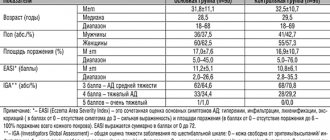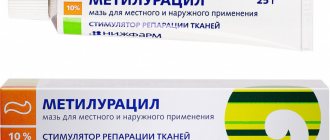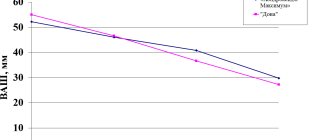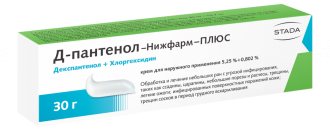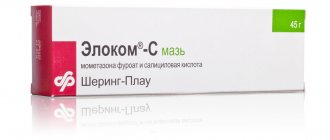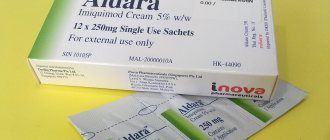Drapolen cream in the treatment and prevention of diaper dermatitis in children in the first months of life
U
In young children, various changes in the skin are observed quite often. The condition of a child’s skin at this age is characterized by its immaturity, increased permeability and sensitivity to a number of factors, such as friction, changes in humidity and temperature, and the influence of irritants [8].
20–30% of newborns have erythema toxicum
, which manifests itself as erythematous, slightly dense spots, sometimes with vesicles in the center. After a few days, the rash disappears without a trace, but may recur periodically. Erythema toxicum is regarded as an allergic reaction to certain components of a child’s diet, most often proteins [3]. Allergic skin reactions in the form of a maculopapular rash are often observed in response to errors in the diet of a nursing mother, the use of human milk substitutes, or when prescribing medications to a child, for example, antibiotics [1].
However, one of the most common skin changes is diaper dermatitis
, the incidence of which ranges from 35 to 50% [6,7]. According to modern concepts, diaper dermatitis is a periodically occurring pathological process provoked by exposure of the child’s skin to mechanical (diaper fabric or diaper), physical (humidity and temperature), chemical (ammonia, digestive enzymes, bile salts) and microbial factors acting internally. diaper or diaper [5]. Clinically, diaper dermatitis is manifested by redness of the skin, papular rash, peeling of the epidermis in the genital area, buttocks, lower abdomen, and inner thighs. In more severe cases, erosions, infiltrates appear in the skin folds, and bacterial and fungal infections occur.
All of the above determines the need to improve the prevention and treatment of diaper dermatitis [4]. Various creams and ointments based on zinc and talc previously used for local treatment, having only adhesive properties, turned out to be insufficient to obtain the desired therapeutic effect.
Cream Drapolene
(GlaxoSmithKline, UK) is a product for external use. The benzalkonium chloride and citrimide contained in the cream have a local antiseptic and disinfectant effect. White soft paraffin, anhydrous lanolin and cityl alcohol have a softening, protective and hydrating effect.
The purpose of the study
was a study of the effectiveness of Drapolen cream in children in the first months of life.
The studies were carried out in the Department of Pathology of Newborn Children of the Clinic of Children's Diseases of the Moscow Medical Academy named after I.M. Sechenov. We observed 114 children aged from 3 days to 1.5 months. There were 68 boys, 46 girls. Most of the children (72%) were born full-term. The main diagnosis in all patients was perinatal damage to the central nervous system.
All children were divided into 2 groups. Group 1 consisted of 61 children who did not have skin allergic manifestations. Group 2 included 53 children with early skin allergic reactions.
During the studies, the health status of the parents was studied, special attention was paid to a family history of allergies (neurodermatitis, food allergies, hay fever, bronchial asthma). A daily general examination of the child was carried out with a detailed assessment of the condition of the skin. The absence or presence of skin changes, their nature, area and area of damage were noted.
In group 1, an analysis of the health status of the parents showed that 56% of children had a history of allergic diseases. No manifestations of toxic erythema or any allergic skin reactions were observed in children. 56.3% of patients were breastfed. Diaper dermatitis was noted in 17 children (28.1%) in the form of erythema of varying prevalence, papular rash, dry skin, which was regarded as a mild degree of the disease (F. Germozo criteria, 1984).
Treatment began at the first manifestations of diaper dermatitis. The drug was applied daily in a thin layer to the affected areas of the skin, including adjacent tissues 4–5 times a day during swaddling. When using Drapolen cream, after removing the diaper, the skin was washed with water without soap (since contact with soap reduces the effectiveness of the cream), dried thoroughly with blotting movements, and then the cream was applied. In most children, improvement was noted already on the 2nd day from the start of treatment: erythema decreased, the rash disappeared, and the area of skin lesions decreased. Treatment continued until the skin changes completely disappeared (on average 3.9±0.6 days). All children showed a positive effect – recovery. There were no adverse reactions from using the cream.
In group 2, a family history of allergies was noted in 72% of children. Manifestations of toxic erythema were observed in 31 children, early skin allergic reactions – in 42 children. The appearance of skin allergic reactions, as a rule, was caused by an error in the diet of a nursing mother, a transfer to early artificial feeding, or a reaction to medications used in the treatment of the child. Only 28.3% of children received breast milk, while the rest were mixed and artificial feeding. Diaper dermatitis was observed in 27 (50.9%) children. In patients of group 2, diaper dermatitis developed significantly more often than in group 1 (p < 0.05). Eight children had a mild course of the disease. The use of Drapolen cream had a positive effect; the duration of treatment averaged 4.1±0.2 days. In 19 children, diaper dermatitis of moderate severity was diagnosed, which was manifested by the development of a pronounced papular rash, erosions, infiltrates in the skin folds, dryness, and peeling of the skin against the background of erythema. In moderate cases of diaper dermatitis, there was no noticeable improvement from the use of Drapolen cream. Despite the treatment, the symptoms of the disease persisted. After 3–5 days of use, Drapolen cream was discontinued, replacing it with other drugs and medical procedures. In children with moderate diaper dermatitis, Drapolen cream was ineffective.
After discharge from the hospital, children with mild diaper dermatitis were recommended to use Drapolen cream for prophylactic purposes: constant application of it to the skin in the area where the diaper fits. Parents were also given advice on child care and rational feeding.
Thus, diaper dermatitis developed more often in children with a family history of allergic diseases and early allergic skin reactions (in most of these patients it occurred in a more severe form).
Drapolen cream is effective in the treatment of mild forms of diaper dermatitis; it can also be recommended for use for preventive purposes. Literature:
1. Avdeeva T.G. The role of the early neonatal period in the formation of the health status of children in the first year of life. Abstract of dissertation of doctor of medical sciences. Moscow, 1996. p.40.
2. Samsygina G.A., Pryamkova Yu.V., Zaitseva O.V. The health status of children born to mothers suffering from bronchial asthma. // Pediatrics. 2001. No. 3. pp. 34–38.
3. Shabalov N.P. Neonatology. St. Petersburg. – 1997. p.112–113.
4. Yatsyk G.V., Stepanov A.A. Use of d-Panthenol ointment in children of the first year of life. Issues of modern pediatrics, 2002, vol. 1, no. 2, pp. 90–92.
5. Berg RW Etiologic factors in diaper dermatitis: A model for development of improved diapers. Pediatrician, 1986, vol.14, no. 1, p. 27–33.
6. Jordan WE, Lawson K., Berg R., Fromxman J. Diaper dermatitis: frequency and severity among a general infant population, Pediatr. Dermatolog, 1986, vol.3, p.198–207.
7. Laine AT, Render PA Evaluations of diaper containing absorbent gelling material with conventional infants. Am.J.DC, 1990, vol. 114, p. 315–319.
8. Liou LW, Janniger CK Skin care of the normal newborn. Cutis, 1997, vol. 59, No. 4, p. 171–174.
